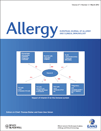Misdiagnosis of exercise-induced bronchoconstriction in professional soccer players
Editor: Michael Wechsler
Abstract
Background:
Physicians typically rely heavily on self-reported symptoms to make a diagnosis of exercise-induced bronchoconstriction (EIB). However, in elite sport, respiratory symptoms have poor diagnostic value. In 2009, following a change in international sports regulations, all elite athletes suspected of asthma and/or EIB were required to undergo pulmonary function testing (PFT) to permit the use of inhaled β2-agonists. The aim of this study was to examine the diagnostic accuracy of physician diagnosis of asthma/EIB in English professional soccer players.
Methods:
Sixty-five players with a physician diagnosis of asthma/EIB were referred for pulmonary function assessment. Medication usage and respiratory symptoms were recorded by questionnaire. A bronchial provocation test with dry air was conducted in 42 players and a mannitol challenge in 18 players. Five players with abnormal resting spirometry performed a bronchodilator test.
Results:
Of the 65 players assessed, 57 (88%) indicated regular use of asthma medication. Respiratory symptoms during exercise were reported by 57 (88%) players. Only 33 (51%) of the players tested had a positive bronchodilator or bronchial provocation test. Neither symptoms nor the use of inhaled corticosteroids were predictive of pulmonary function tests’ outcome.
Conclusion:
A high proportion of English professional soccer players medicated for asthma/EIB (a third with reliever therapy only) do not present reversible airway obstruction or airway hyperresponsiveness to indirect stimuli. This underlines the importance of objective PFT to support a symptoms-based diagnosis of asthma/EIB in athletes.




